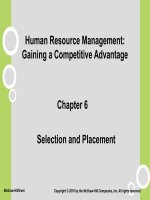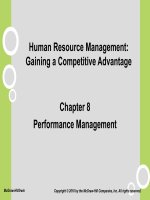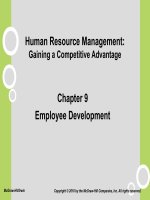Human resource management gaining a competitive advantage 2014 chapter 10
Bạn đang xem bản rút gọn của tài liệu. Xem và tải ngay bản đầy đủ của tài liệu tại đây (727.57 KB, 16 trang )
Human Resource Management:
Gaining a Competitive Advantage
Chapter 10
Employee Separation and
Retention
McGraw-Hill/Irwin
Copyright © 2013 by The McGraw-Hill Companies, Inc. All rights reserved.
Introduction
To compete, organizations must ensure:
Good performers are motivated to stay.
Chronically low performers are allowed, encouraged
or if necessary, forced to leave.
2 Types of Turnover:
Involuntary turnover—initiated by the organization
(often among those who would prefer to stay).
Voluntary turnover—initiated by employee
(often those the company would prefer to keep).
10-2
Managing Involuntary
Turnover
Employment-at-will doctrine- in the
absence of a specific contract, either an
employer or employee could sever the
employment relationship at any time.
Violence in the workplace caused by
involuntary turnover has become a major
organizational problem.
A standardized, systematic approach to
discipline and discharge is necessary.
10-3
Principles of Justice
Outcome fairness-the judgement that
people make regarding outcomes received
relative to outcomes received by others with
whom they identify.
Procedural justice- focuses on methods
used to determine the outcomes received.
Interactional justice- the interpersonal
nature of how the outcomes were
implemented.
10-4
Progressive Discipline
10-5
4 Stages of
ADR
Open Door Policy
10-6
Employee Assistance Programs
EAPs attempt to ameliorate problems
encountered by workers who are drug
dependent, alcoholic, or psychologically
troubled.
EAPs are usually identified in official
documents published by the employer.
10-7
Managing Voluntary Turnover – Job
Withdrawal
Progression of Withdrawal Theory-
dissatisfied individuals enact a set of
behaviors in succession to avoid their work
situation.
3 categories:
1. behavior change
2. physical job withdraw
3. psychological job withdraw
Withdrawal behaviors are related to one
another, and partially caused by job
dissatisfaction.
10-8
Job DissatisfactionJob Withdrawal Process
10-9
Behavior Change
An employee's first response to dissatisfaction
would be to try to change conditions that
generate dissatisfaction.
When employees are unionized, dissatisfaction
leads to increased grievances.
Employees sometimes initiate change through
whistle-blowing-making grievances public by
going to the media or government.
10-10
Physical Withdrawal
4 ways a dissatisfied worker can physically
withdraw from the organization:
1.
2.
3.
4.
Leave the job
Internal transfer
Absenteeism
Tardiness
Companies spend 15 % of payroll costs to
make up for absent workers on average.
10-11
2 Forms of Psychological
Withdrawal
10-12
Job Satisfaction and Job
Withdrawal
Job satisfaction is a pleasurable feeling
that results from the perception that
one's job fulfills one's important job
values.
3 aspects of job satisfaction:
1. Values
2. Perceptions
3. Importance
10-13
Sources of
Job
Dissatisfaction
10-14
Sources of Job
Dissatisfaction
Personal Dispositions
Negative affectivity is a dispositional
dimension that reflects pervasive individual
differences in satisfaction with any and all
aspects of life.
Tasks and Roles
The nature of the task itself is the key
predictor of job dissatisfaction.
Job Rotation
Pro-social Motivation
10-15
Sources of Job Satisfaction
Supervisors and Coworkers
A person may be satisfied with his or her
supervisor and coworkers due to:
shared values, attitudes, and philosophies,
strong social support
Pay and Benefits
Pay is a reflection of self-worth, so pay
satisfaction is significant when it comes to
retention.
10-16









